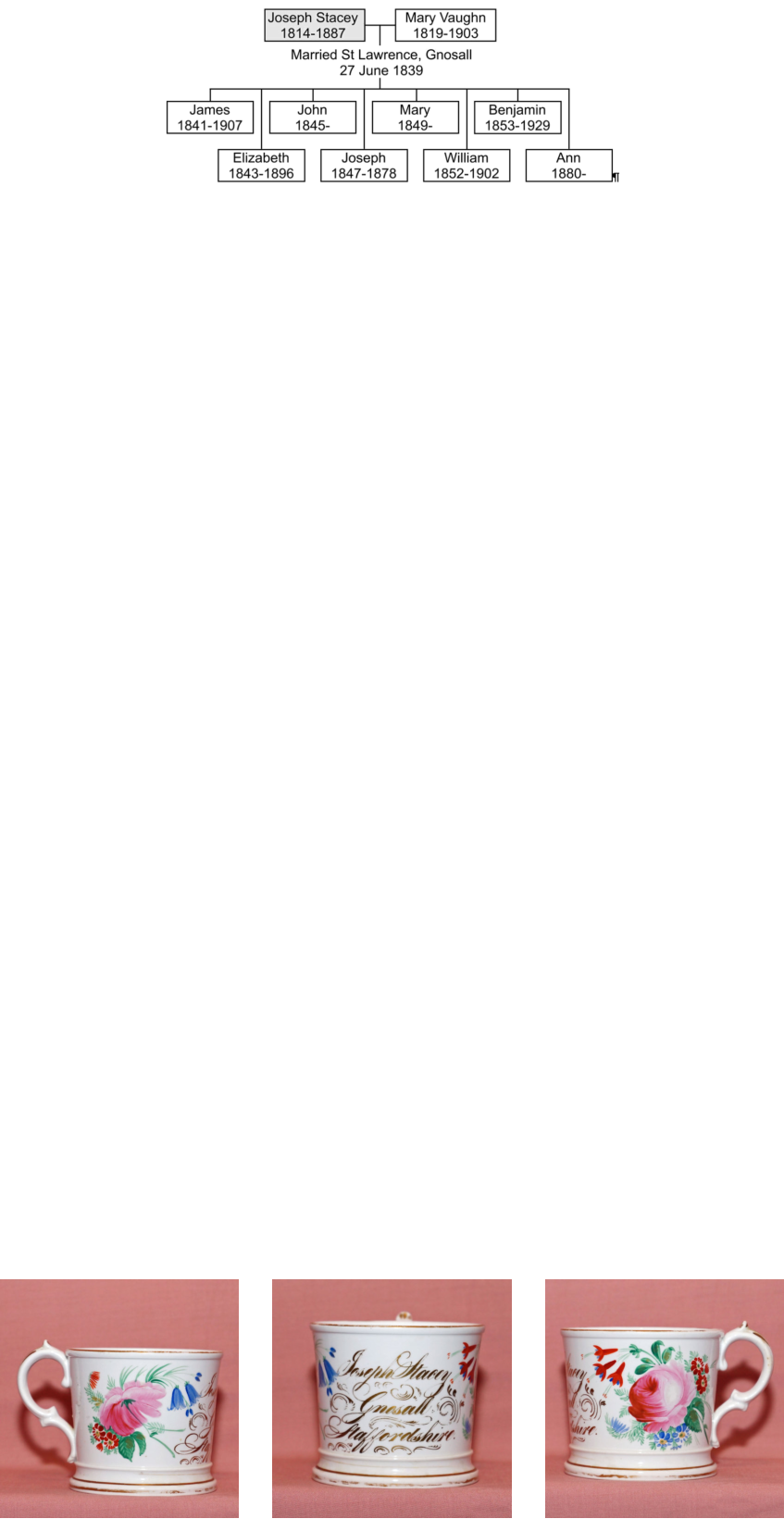Joseph Stacey 1814 - 1887
Joseph Stacey was baptised in Church Eaton (Orslow) 13 October 1814. His parents were James and Elizabeth Stacey.
On 27 June 1839 he married Mary Vaughn at St Lawrence Church, Gnosall. The certificate indicates they were both
resident at Great Chatwell. Joseph was a wheelwright and Mary a servant. According to later census records she was born
at High Ercall or Crudginton, Shropshire.
1841 census living at Orslow with wheelwright father James, and working as a wheelwright. His wife was with him.
1851 census living at Orslow as wheelwright employing three men. Also there was his Wife, three sons and two daughters.
In 1857 and 1858 he placed notices in the “Staffordshire Advertiser” promoting shooting competitions to be held at the
Fountain Inn to win a fat pig.
(Other newspaper reports indicate Benjamin Lowe had been at the Fountain Inn 1855 and 1856 so Joseph Stacey was
newly arrived there).
On the 1861 Gnosall census he is at the Fountain Inn as a wheelwright with his wife Mary, four sons, and two daughters -
all but the youngest daughter Ann born at Orslow. Ann was born in Gnosall and baptised at St Lawrence Church on 18
February 1860. His son John aged 16 is also described as wheelwright.
On 25 November 1862 the “Cordwainers’ Friendly Society and Sick Club” (known as the “Trump of Hearts” Friendly
Society) met at the Fountain Inn with Joseph Stacey as chairman.
In December 1862 was charged with “lending out an unjust steelyard". This was a standard measure of weight which
“weighed several ounces against the purchaser”. Because they weren’t in use at the time of the seizure, Joseph was
acquitted.
In July 1863 the Fountain Inn and a number of parcels of arable land and land for building were advertised as being
auctioned off. The newspaper indicates that Joseph Stacey was the occupier but not necessarily the owner.
On 27 June 1868 The Stafford Advertiser reported that the “Cowley Friendly Society” (known as the “Ginger Club”) held
their anniversary with a procession to the Church then afterwards “dined at the house of Mr. Stacey of the Fountain Inn”,
though he was no longer in the Chair.
On the 1871 census he is still at the Fountain Inn with family, as innkeeper and wheelwright. His son William aged 18 is
also described as wheelwright.
On the 1881 census he was now in Orslow, Church Eaton, farmer and wheelwright
He died 2nd Sept 1887 at Orslow. His estate worth £217 13s 10d, son William an executor
Interesting Descendants
Benjamin Stacey
One of Joseph’s sons was Benjamin born in 1853. He married Martha Ellsmoor in 1884. For a time he was licensee
of the Royal Oak and became a dealer in coal and timber having a timber yard located behind the fish and chip
shop which he ran for many years with the help of his son Frank. He later lived opposite at Rose Villa. Stacey
Gardens is named after the family.
In 1936 Frank Stacey married Amy Rose who kept a sweet shop in the High Street, now a greengrocers and still
known as “Old Stacey’s”
Maurice Stacey 1907-1994
One of Joseph’s great grandsons (vis: son-John, grandson-John Henry) was Maurice born at Moreton in 1907.
Appointed lecturer in Chemistry at Birmingham in 1937, he was eventually promoted to Professor of Chemistry in
1946 and became Mason Professor and Head of Department in 1956, a post which he held until his retirement in
1974. He was elected a Fellow of the Royal Society in 1950, and in 1966 was appointed CBE. His achievements
are too numerous to list here but can be easily found by googling his nam
Joseph Stacey Mug
In October 2015 Gnosall Heritage Group purchased a china mug from an ebay seller in Canada. Details were sent to
the Pottery Museum and Art Gallery in Hanley and this is their response:
The mug is a bone china presentation mug of a shape popular in the mid-19
th
century. It is decorated with hand-
painted flowers to either side of the gilt inscription. They were very popular as gifts throughout the 19
th
century, often
produced with just the enamelled decoration so that the purchaser could decide on the inscription, which was then
added in gold.
These presentation pieces are hard to date as the shapes and style of decoration, as well as the gilding, are slow to
change. The majority of dated examples occur from the period c.1840-1870.

Click above for home screen



















